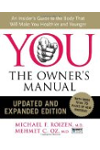Advertisement
I know performing self-medical tests can be about as appealing as catheter insertion, but this one's easy. You can do it in just a minute, you can grade yourself, and you'll get the results immediately.
The test? Briskly run up two flights of stairs or walk six blocks. That's it. If you can do either of those without pausing to rest, your lungs are probably in pretty good shape.
This is actually a test to determine whether someone is fit for surgery. For those who pass the test, it indicates a decrease in your risk of dying or being disabled in surgery to that of someone who is about 10 years younger. This benefit occurs because passing the test indicates their lung's ability to provide oxygen and exhale carbon dioxide.
It's a simple grading system: pass/fail. Make it up the two flights without spewing out more air than an industrial-size fan and you pass. But if you experience extreme shortness of breath or have to stop, it's a sign your lungs are suffering at least some distress, even if it's the heart's fault.
I recommend that you do this test every month, as a way of periodically checking your lung function and gaining insights of your overall fitness level. That's important, because one of the major warning signs of decreased lung function is seeing a severe change in your ability to complete the test-from being able to run the flights easily to suddenly having a lot of trouble with it.
The reason? When you exercise over this compact period of time, shortness of breath means all your organs are feeling deprived of oxygen, and that some of them might not be getting enough.
The test? Briskly run up two flights of stairs or walk six blocks. That's it. If you can do either of those without pausing to rest, your lungs are probably in pretty good shape.
This is actually a test to determine whether someone is fit for surgery. For those who pass the test, it indicates a decrease in your risk of dying or being disabled in surgery to that of someone who is about 10 years younger. This benefit occurs because passing the test indicates their lung's ability to provide oxygen and exhale carbon dioxide.
It's a simple grading system: pass/fail. Make it up the two flights without spewing out more air than an industrial-size fan and you pass. But if you experience extreme shortness of breath or have to stop, it's a sign your lungs are suffering at least some distress, even if it's the heart's fault.
I recommend that you do this test every month, as a way of periodically checking your lung function and gaining insights of your overall fitness level. That's important, because one of the major warning signs of decreased lung function is seeing a severe change in your ability to complete the test-from being able to run the flights easily to suddenly having a lot of trouble with it.
The reason? When you exercise over this compact period of time, shortness of breath means all your organs are feeling deprived of oxygen, and that some of them might not be getting enough.

More About this Book
YOU: The Owner's Manual, Updated and Expanded Edition: An Insider's Guide to the Body that Will Make You Healthier and Younger
Between your full-length mirror and high-school biology class, you probably think you know a lot about the human body. While it's true that we live in an age when we're as obsessed with our bodies as...
Continue Learning about Lung Disease and Respiratory System
Important: This content reflects information from various individuals and organizations and may offer alternative or opposing points of view. It should not be used for medical advice, diagnosis or treatment. As always, you should consult with your healthcare provider about your specific health needs.


